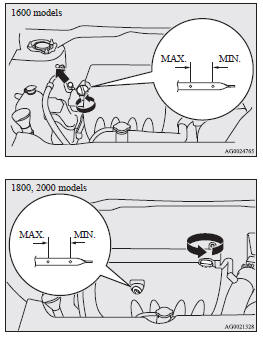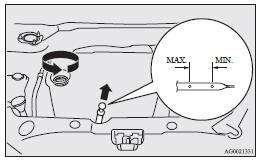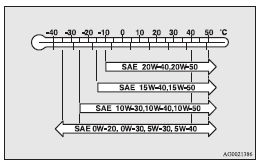Engine oil
To check and refill engine oil
Petrol-powered vehicles

Diesel-powered vehicles

The engine oil used has a significant effect on the engine’s performance, service life and startability.
Be sure to use oil of the recommended quality and appropriate viscosity.
All engines consume a certain amount of oil during normal operation. Therefore, it is important to check the oil level at regular intervals or before starting a long trip.
1. Park the car on a horizontal surface.
2. Switch off the engine.
3. Wait a few minutes.
4. Remove the dipstick and wipe it with a clean cloth.
5. Reinsert the dipstick as far as it goes.
6. Remove the dipstick and read the oil level, which should always be within
the range indicated.
7. If the oil level is below the specified limit, remove the cap located on the
cylinder head cover and add enough oil to raise the level to within the specified
range. Do not overfill to avoid engine damage. Be sure to use the specified engine
oil and do not mix various types of oil.
8. After adding oil, close the cap securely.
9. Confirm the oil level by repeating step 4 to 6.
![]() CAUTION
CAUTION
• In diesel-powered vehicles, when burning away and removing soot accumulated in the DPF, fuel can mix with the engine oil and an increase in the engine oil level may occur. This does not indicate an abnormality.
However, if the engine oil level is at or over the “X” mark (B) on the engine oil dipstick (A), change the engine oil.

![]() NOTE
NOTE
• The engine oil will deteriorate rapidly if the vehicle is subjected to severe conditions, requiring earlier oil replacement.
Please refer to the maintenance schedule.
• For information on how to dispose of used engine oil, refer to page 05.
Recommended engine oil viscosity
Petrol-powered vehicles

• Select engine oil of the proper SAE viscosity number according to the atmospheric temperature.
SAE 0W-20, 0W-30, 5W-30, and 5W-40 engine oils can only be used if they meet ACEA A3/B3, A3/B4 or A5/B5 and API SM specifications.
• Use engine oil conforming to the following classification:
• API classification: “For service SM”
• ILSAC certificated oil
• ACEA classification:
“For service A1/B1, A3/B3, A3/B4 or A5/B5”
• Use of additives is not recommended since they may reduce the effectiveness of additives already included in the engine oil. It may result in failure of the mechanical assembly.
Diesel-powered vehicles

• Select engine oil of the proper SAE viscosity number according to the atmospheric temperature.
• Use engine oil conforming to the following classification:
• ACEA classification:
“For service C1, C2, C3 or C4”
• JASO classification:
“For service DL-1”
If those classifications are not available, contact a MITSUBISHI MOTORS Authorized Service Point.
![]() NOTE
NOTE
• Use of additives is not recommended since they may reduce the effectiveness of additives already included in the engine oil. It may result in failure of the mechanical assembly.
See also:
Sunshade
Slide the sunshade (5) manually to open and close it.
NOTE
The sunshade will operate together with the sunroof only when the sunroof
is opened.
CAUTION
Do not attempt to close the sunshade whe ...
Lamps (headlamps, fog lamp, etc.) auto-cutout function
• If the following operation is performed while the lamp switch is in the
position, the lamps will automatically
go out when the driver’s door is opened.
[Except for vehicles equipped with ke ...
Ride Quality & Noise
When you're not having fun tossing this car around, you're really not having
fun. The ride is harsher than an all-wheel-drive Lancer we tested without the
sports suspension; rough roads jostle the ...
